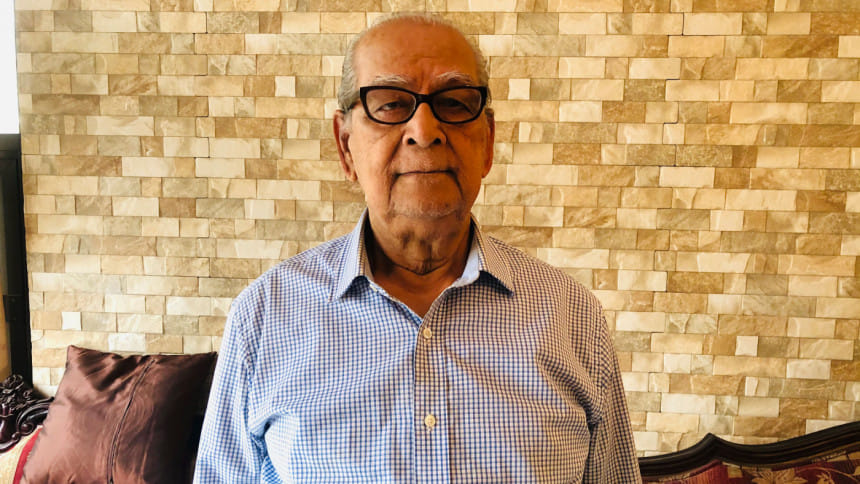‘Agartala case provided a spark for our dream of independence’

Amanullah is a former Director General of Press Institute of Bangladesh (PIB) and former Chief Editor of Bangladesh Sangbad Sangstha (BSS). The author of an upcoming book on the Agartala Conspiracy Case, he covered the historic trial while working for Associated Press of Pakistan (APP). On the occasion of the 52nd anniversary of the withdrawal of this case on February 22, 1969, he talks to Badiuzzaman Bay of The Daily Star about its backdrop, his experience of witnessing court proceedings, and how the case provided a spark for our independence movement.
How did you come to be involved with the Agartala Conspiracy Case?
It was sometime around mid-1960s when a group of Bengali officers of the Pakistani armed forces organised themselves for a planned rebellion against the government. They were able to maintain strict secrecy about their activities for quite some time. Later, it transpired that the plan was foiled because of the betrayal of one of the members of the group. Sergeant Amir Hossain surrendered and gave out their secret plan, exposing his fellow rebels to great risk. Security agencies swung into action and made a number of arrests of suspected rebels working in the defence forces of both wings of Pakistan.
I remember I was in Rawalpindi then. It was perhaps towards the end of 1967 that I could learn from a very reliable source that General Ayub Khan was thinking of trying the suspected rebels for treason. I came to know that he initially thought of trying them in a military court in camera. The government also thought of a trial in camera by a special tribunal with civilian judges. However, finally, it decided to conduct an open trial by a special tribunal with judges from Supreme Court and High Court.
SM Zafar was then the federal minister for law and parliamentary affairs, and as such, a key person in respect of the proposed trial. During my coverage of the National Assembly proceedings before, I had come into close contact with SM Zafar, and he became a dependable news source for me. So one day, he invited me for a private meeting to assess the possible public reaction in East Bengal to the planned trial. I told him that whatever might be the procedure of the trial, either by court martial or trial by a special court, open or in camera, the Bengali reaction was bound to be angry. I also suggested conducting the trial, if they must, by civilian judges in an open court. Later developments suggest the government took the issue of public reaction seriously.
Eventually, when the trial began, I was assigned by APP's then-head Safdar Ali Qureshi to cover it along with my senior colleague HR Batalvi and Mojammel Haque. Batalvi returned to Pindi after about a week, leaving me and Mojammel to cover the case till its abrupt withdrawal on February 22, 1969 at the height of a popular movement.
What can you tell us about the trial?
I still remember the opening day of the trial in Dhaka's Kurmitola cantonment on June 19, 1968. It was well before nine in the morning when journalists entered the tribunal chamber and took their assigned seats in the small, congested press gallery, just on the right-hand side of the judges. Before entering the court chamber, we were cautioned by security men against talking during the court proceedings. Earlier, journalists had been issued passes for the coverage of the trial. It was shortly before nine when the 35 accused—including the principal accused Bangabandhu Sheikh Mujibur Rahman—were brought in and led to the dock, an enclosure with wooden railing. There was pin-drop silence in the courtroom when they entered. The seats for the accused were also fixed, possibly because of the gravity of the charges brought against them. Among the accused, the first one to enter was Bangabandhu, wearing white pajama and panjabi, and he approached his seat with confident steps. On the first day, Bangabandhu's father, Sheikh Lutfar Rahman was also present in the chamber, as were his children.
It should be mentioned that Bangabandhu was implicated in the case merely for political reasons and not for any action on his part in connection with the so-called conspiracy. Although he was described as the leader of the movement, the prosecution's statement itself showed that Lt. Com. Moazzem Hossain, who was shown as accused number two, played the most important role and Mujib's was only of a secondary character in the organisational set-up of the revolutionary group. It was Moazzem along with a few others like Steward Mujib, Sultanuddin and Noor Mohammad who were in the "process of forming an organisation for the independence of East Pakistan". During the trial and in its aftermath, I came to know Moazzem closely and was privy to many of his thoughts and decisions.
Can you recall any incidents from the trial?
There are in fact many, and in my book, I'm going to provide a day-to-day coverage of the trial. I can tell you about one particular incident. On September 4, 1968, Kamaluddin, an accused-turned-approver, complained from the witness box about physical and mental torture that he had endured while in custody, leading the prosecution to declare him a "hostile" witness. The emotional outburst of Hasina Kamal, Kamaluddin's wife, in the courtroom was hard to forget. Even the judges were moved. Kamaluddin's release on bail later may have consoled his wife and old mother-in-law. But Hasina Kamal would still come to the tribunal where her brother Sultanuddin was still facing the ordeal as an accused. There were so many incidents like this—sometimes interesting and often tragic—involving the accused, their relatives and lawyers, prosecutors, witnesses, journalists and even judges. These incidents show that the courtroom drama was no less intense as the one unfolding out on the streets, with the people coming out in their thousands, enraged by the absurdity of the Pakistani attempt.
As a journalist, you closely observed the trial and its aftermath. How significant is the case in the history of our independence?
The Agartala case provided a spark for the independence movement. Until that point, Bengalis had in their minds the contours of some kind of a vision for autonomy or self-determination. There was a need for a conflict for the dream of independence to burst onto the scene, and this case created the occasion for that conflict—a point of no return for those still in doubt. It made the appeal of a revolt for freedom that much convincing. The history of the Agartala case is a must read for today's generation. It shows us that the Liberation War was not fought in those nine months only; it had its origin a long time ago. It also shows us that good things may come out of a bad development if we remain persistent to achieve our goal.

 For all latest news, follow The Daily Star's Google News channel.
For all latest news, follow The Daily Star's Google News channel. 



Comments